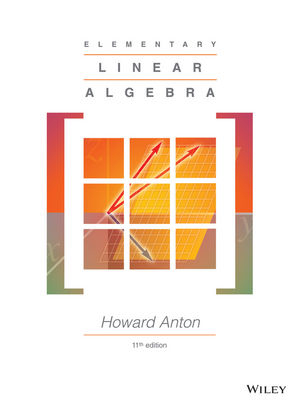
Elementary Linear Algebra, 11th Edition
By Howard Anton
Elementary Linear Algebra gives an elementary treatment of linear algebra that is suitable for a first course for undergraduate students. The aim is to present the fundamentals of linear algebra in the clearest possible way; pedagogy is the main consideration. Calculus is not a prerequisite, but there are clearly labeled exercises and examples (which can be omitted without loss of continuity) for students who have studied calculus.
Schedule a Demo Sign Up for a Test Drive Adopt WileyPLUSWant to learn more about WileyPLUS? Click Here
Read, Study, and Practice
Students learn course concepts using the complete online eTextbook, flashcards, crossword puzzles, practice questions, videos, and animations. Organized by learning objective, students can filter for relevant learning resources based on what they need to study most and print any section of the eTextbook.
ORION Adaptive Practice (when available)
Every student has a different starting point, and adaptive practice provides endless opportunities for practice to effectively prepare for class or quizzes and exams. Active retrieval of information with practice questions is proven to improve retention of information better than re-reading or reviewing the material, and students who use adaptive practice to prepare for exams do significantly better than those who do not. Students begin with a quick, chapter-level diagnostic to determine their initial level of understanding, and they can use the dashboard and quick reports to see what topics they know and don’t know.
Assignments
Students who fully engage in WileyPLUS assignments do better in the course by more than a letter grade. Auto-graded assignments give students immediate feedback based on flexible assignment settings determined by the instructor, while the notification center allows students to set their own email notification policies to stay on track.
Instructors can select from extensive and reliable question banks to create and deploy reading, practice, homework, pre-post lectures, and assessment assignments. This course includes essay, label drag-and-drop, multiple choice, text entry, and true-/false question types.
Gradebook
Students know where they stand on WileyPLUS assignments, and they can track progress by learning objective.
Instructors have insights into student performance at the granular question attempt and can track trends by individual student, assignment, or learning objective. Flexible policies allow instructors to change points, set assignment weighing policies, extend individual due dates, or drop the lowest grade.
Howard Anton obtained his B.A. from Lehigh University, his M.A. from the University of Illinois, and his Ph.D. from the Polytechnic Institute of Brooklyn, all in mathematics. He worked in the manned space program at Cape Canaveral in the early 1960’s. In 1968 he became a research professor of mathematics at Drexel University in Philadelphia, where he taught and did mathematical research for 15 years. In 1983 he left Drexel as a Professor Emeritus of Mathematics to become a full-time writer of mathematical textbooks. There are now more than 150 versions of his books in print, including translations into Spanish, Arabic, Portuguese, French, German, Chinese, Japanese, Hebrew, Italian, and Indonesian. He was awarded a Textbook Excellence Award in 1994 by the Textbook Authors Association, and in 2011 that organization awarded his Elementary Linear Algebra text its McGuffey Award. Dr. Anton has been President of the EPADEL section of the Mathematical Association America, served on the Board of Governors of that organization, and guided the creation of its Student Chapters. For relaxation, Dr. Anton enjoys traveling and photography.
Chapter 1. Systems of Linear Equations and Matrices
Chapter 2. Determinants
Chapter 3. Euclidean Vector Spaces
Chapter 4. General Vector Spaces
Chapter 5. Eigenvalues and Eigenvectors
Chapter 6. Inner Product Spaces
Chapter 7. Diagonalization and Quadratic Forms
Chapter 8. General Linear Transformations
Chapter 9. Numerical Methods
A. Working with Proofs
B. Complex Numbers
Answers to Exercises
Index

